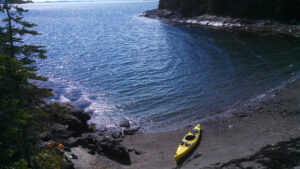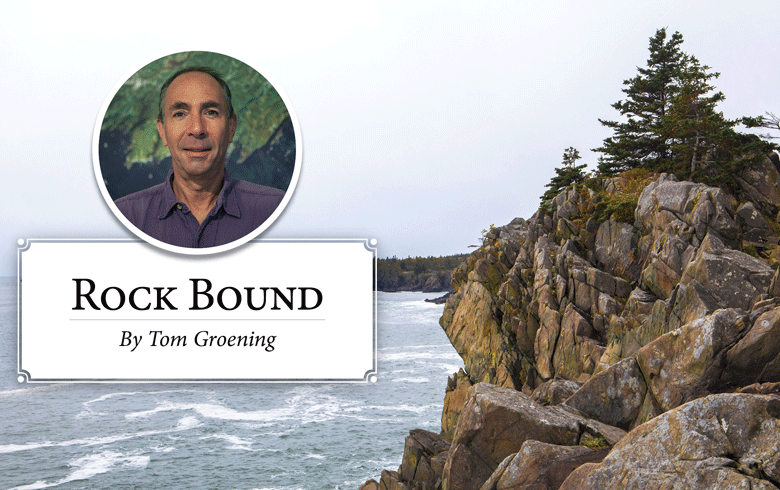We are inexorably drawn to water. We embrace a quiet swim in a remote pond on a hot summer afternoon, revel in a dive into a pool. A soak in a hot tub or even a hot shower on a chilly morning can be sublime, and a winter’s walk on a sandy ocean beach or sitting beside a roaring steam in spring bestow the same rewards.
I suppose it’s not surprising we are drawn to water. We spend the first nine months of our lives floating in it.
My wife Gail swims laps in the ocean during the warm months and switches to the YMCA pool in the cold months. My favorite connection to the water world comes through kayaking.
Almost 30 years ago, family chipped in and bought me a tandem kayak. Gail and I hauled it to some favorite coastal spots, and I would take our kids out, one at a time. It was a good introduction, but when I took a course at Maine Sport Outfitters in Rockport with instructor Ben Fuller using a single kayak, I was converted.
Your knees should be pressed against the underside of the hull, so you’re “wearing” the boat, as guides say.
The tandem felt like an ocean liner in comparison, and we sold it. About 20 years ago, my father bought me a single kayak, an Old Town Egret. It’s plastic, and so if I ever paddled with folks with sleek fiberglass models, I might not be able to keep up.
But I paddle alone. I need a fair amount of solitary time, and kayaking is just the ticket.
It’s an intimate connection to the ocean. With a kayak, your butt is at or below the waterline. Your knees should be pressed against the underside of the hull, so you’re “wearing” the boat, as guides say.
Lakes are fine, but there’s something infinite about the ocean. It feels like a living, breathing thing, with the omnipresent forces of tide, wind, and wave. And they are often three distinct forces to contend with.
The first time I paddled from Castine Harbor up the Bagaduce River (a favorite trip), I arrived late and faced fighting the falling waters. But it wasn’t too bad. A couple of hours later I glided up to the reversing falls area by Bagaduce Lunch, and stared, incredulously at the water moving away from me. Had I misread the tide chart?
I spoke to my Bangor Daily News editor and kayak guide Jeff Strout, who told me it takes that long for the tide to work its way up the river.

Circumnavigating islands is my thing. I’ve paddled around Long Island in Blue Hill Bay (10-plus miles) a couple of times, as well as around Bartlett Island off the west side of MDI. I’ve done Verona Island (too many low tide mudflats), Sears Island several times, and even Little Deer Isle.
For that one, I put in at the base of the bridge and timed the high tide so I could get my boat close to the causeway. I carried the boat—laughing at the scene I was making—as pickups whizzed by on Route 15. Still, a lovely day.
I’ve covered most of both shores of Eggemoggin Reach (slaloming around some of the islands near Naskeag). I had hoped this summer to do Bois Bubert Island off Milbridge. Tick-tock.
Southern Maine’s sandy shores haven’t worked out. Once, I paddled down the Scarborough River, out to Prout’s Neck, turned around and, on a stop upriver, glanced at my phone and saw that I was in fact on the (aptly named) Nonesuch River.
While we still had the tandem, we rented a couple of single boats and Gail and our daughter paddled the double while our son and I enjoyed the singles. We did two trips; one from Lincolnville to Islesboro, where we circumnavigated Seven-Hundred Acre Island, and another from Seal Cove on MDI over to Southwest Harbor and back.
The Islesboro trip was fun, but on the way back, we had 4-foot following seas. A little dicey for our then-12-year-old son. These days I stay close to shore. I’ve never flipped, but I should brush up on my self-rescue skills.
When the water is cool, I stow sweatpants and a sweater to change into if I have to swim to shore. And I never take off my PFD while in the boat. The greatest danger, it seems to me, is getting hit by a boat whose captain is busy baiting traps. A lobsterman I know calls kayaks speed bumps.
I’ve met couples in their 70s who paddle regularly, so I hope to be able to continue exploring for another decade. If only I had more time off…
Tom Groening is editor of The Working Waterfront. He may be contacted at tgroening@islandinstitute.org.





